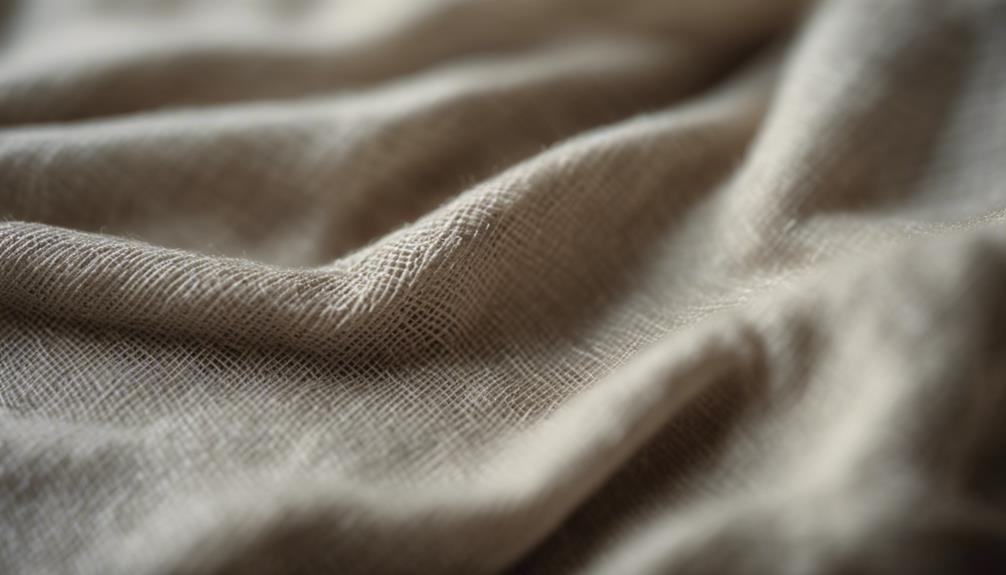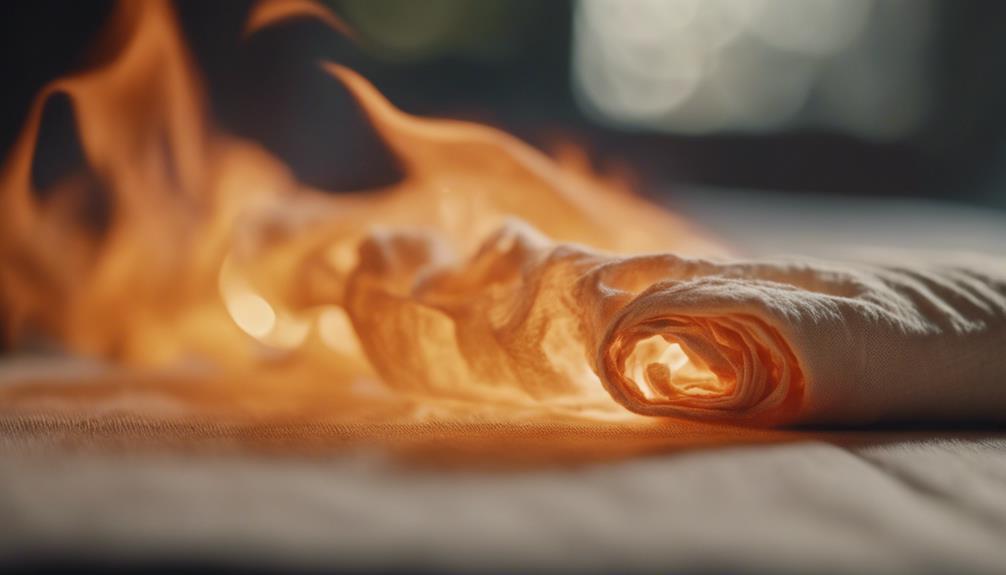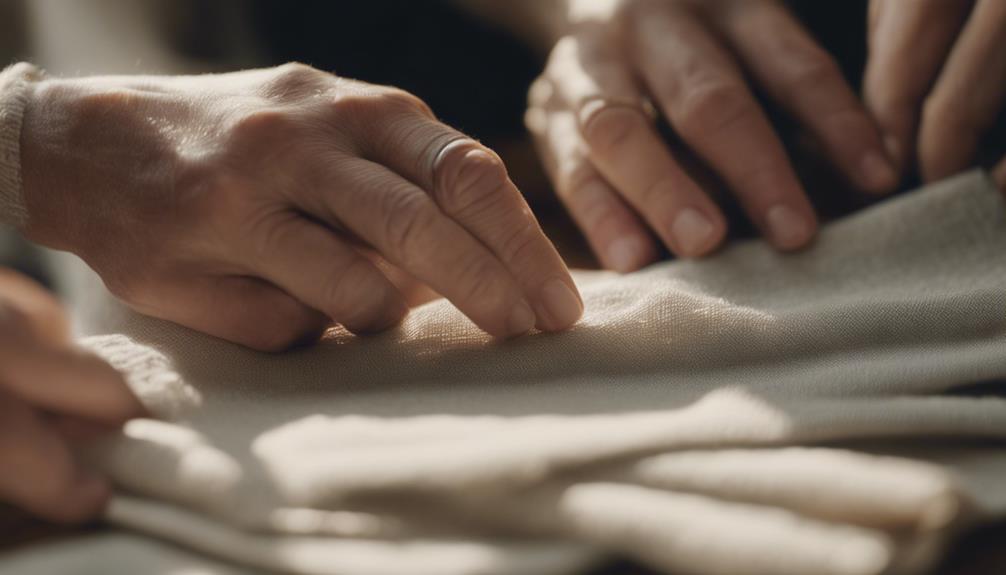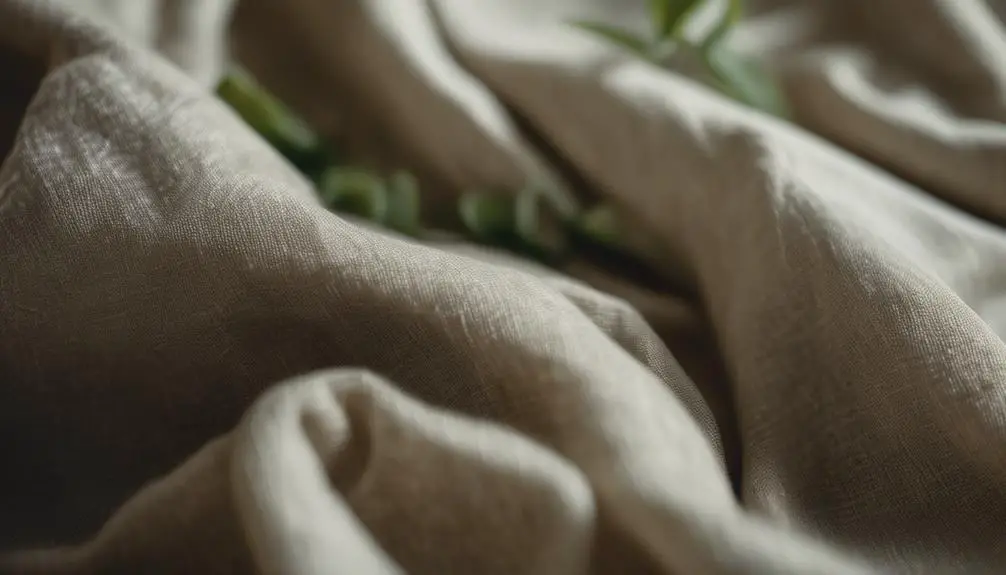To identify linen, start by checking its texture and weight. Linen's unique roughness and irregular slubs set it apart from smoother fabrics like cotton. You'll notice its subtle sheen and lightweight feel, perfect for warm weather. The burn test is another method; linen ignites quickly and smells like burning paper, leaving soft ash. Also, look for labels—authentic linen should say 100% linen or flax. Conducting a moisture absorption test can help too, as linen absorbs water quickly. There's much more to explore about this versatile fabric, so keep going to uncover additional tips and tricks for identification!
Natural Flax Fiber Characteristics

When you look at linen, you're seeing the remarkable characteristics of natural flax fibers. These fibers have a unique texture that sets linen apart from other fabrics. You'll notice the irregular thickness and slight bumps, known as slubs, which contribute to its distinctive appearance. This rough texture not only adds visual interest but also tells you the fabric's flax origin.
Flax fibers possess a natural luster, giving linen a subtle sheen. However, they have low elasticity, which means linen wrinkles easily—something to take into account if you're aiming for a polished look. But don't worry; many people appreciate this casual, relaxed vibe that linen naturally offers.
Additionally, flax fibers are highly absorbent, allowing linen to wick moisture effectively. This quality makes linen a comfortable choice for warm weather, keeping you cool and dry. The plain weave pattern commonly found in linen enhances its unique texture, further emphasizing its rustic charm. So, when you touch linen, you're not just feeling a fabric; you're experiencing the essence of flax fibers, each imperfection telling a story of its natural heritage.
Fabric Weight and Texture
Linen's fabric weight and texture play a significant role in its appeal, especially for those seeking comfort in warm weather. Typically lightweight, linen is perfect for clothing and home textiles designed to keep you cool. When you touch linen, you'll notice its rough and slightly crisp texture, which sets it apart from smoother fabrics like cotton. This distinct texture comes from the unique fiber structure of flax, featuring irregular, thick fibers that contribute to its casual, relaxed aesthetic.
One of the hallmark traits of linen is its tendency to wrinkle easily, adding to its charm. This characteristic makes it ideal for laid-back styles, as it exudes an effortless vibe. When handling linen, pay attention to its fabric weight; it feels light yet substantial, providing a satisfying sensation that confirms its natural composition.
Weave Patterns of Linen

A close look at linen reveals its signature weave patterns, which are vital for identifying this unique fabric. Typically, linen features a plain weave pattern, where the fibers are woven over and under in a straightforward manner. This creates a distinctive, natural texture that sets linen fabrics apart from others.
When you examine the weave closely, you'll notice the irregular and thick fibers that contribute to linen's unique appearance, often resulting in visible slubs and bumps. These elements play a significant role in the overall aesthetic and feel of the fabric. Unlike smoother textiles like cotton, the rough texture of linen is apparent upon inspection.
The plain weave not only defines the look but also influences the fabric's lightweight quality, making it perfect for breathable clothing and home textiles. By analyzing the weave patterns, you can accurately identify linen and appreciate its specific properties and craftsmanship. So, next time you encounter linen, pay attention to these details; they'll help you recognize the unique qualities that make this fabric a favorite in your wardrobe and home.
Importance of Labels
Understanding the weave patterns of linen is just one part of identifying this unique fabric; labels play a significant role as well. When you check a label, it often provides essential information about material composition. Look for terms like 100% linen, flax, or linum, which confirm you're dealing with genuine linen. If the label indicates a blend with fibers like cotton, it's important to observe the percentages since this can affect the fabric's properties and care needs.
Additionally, labels usually contain care instructions specific to linen, such as requiring gentle washing or air drying to maintain its quality. If you find a label that doesn't list fiber content, it might hint at lower quality or poorly manufactured fabric, prompting you to investigate further.
Manufacturers typically include details about fabric type on labels, making it easier for you to verify the authenticity of linen products. By paying attention to these labels, you can confidently identify linen and guarantee you're making an informed purchase.
Conducting the Burn Test

When you're looking to identify linen, conducting the burn test can be a straightforward and effective method. Linen, made from flax, has distinct burning characteristics that set it apart from other fabrics. To perform the burn test, take a small snippet of the fabric and carefully light it. Watch how it burns; linen ignites quickly and produces a flame that resembles burning paper.
As the fabric burns, observe the residue left behind. Unlike synthetic fabrics, which tend to melt and form hard blobs, linen burns to a soft ash. The smell is also telling—if you detect an odor similar to burning paper, you're likely dealing with linen.
Safety is vital during the burn test, so make sure you're in a controlled environment where you can monitor the flame closely. Caution is essential, as you need experience to interpret the results accurately. Remember, the burn test is a reliable way to identify linen fabric, but always proceed with care to prevent any accidents. By following these guidelines, you'll be better equipped to distinguish linen from other materials confidently.
Moisture Absorption Test
Another effective method for identifying linen is the moisture absorption test. To perform this test, wet your fingertip with water and press it against the fabric. Pay attention to how quickly the moisture transfers through. If you notice immediate moisture transfer to the opposite side, it indicates the presence of linen, which is renowned for its high absorbency. Linen's hygroscopic properties allow it to absorb moisture effectively, making it a cooler and more comfortable option in warm weather.
In contrast, if you experience slower moisture transfer, you're likely dealing with a different fabric type, such as cotton fabric or synthetic fibers. These materials absorb moisture less rapidly than linen, which can help you distinguish between them. For the most accurate results, make sure you're using a clean fabric sample. This simple test can provide reliable identification of linen and help you understand its unique benefits when it comes to clothing and home textiles. By understanding the moisture absorption characteristics of linen, you can make informed choices about your fabric selections.
Community Insights and Tips

How can you make sure you're correctly identifying linen? Start by performing the burn test. When you burn a small piece of the fabric, genuine linen will produce fine ash and a paper-like smell, while synthetic fabrics melt and leave hard residues. Checking fabric labels is also essential; look for terms like 100% linen, flax, or linum, as opposed to 100% cotton or blends.
Another effective method is the moisture transfer test. Press a wet fingertip against the fabric. If it absorbs moisture quickly, you're likely dealing with linen. Community feedback suggests comparing the texture and weight of the fabric with known linen samples. Linen typically has a rougher texture and a heavier feel, which can help in your identification process.
Visual and Tactile Differences
Identifying linen involves observing its unique visual and tactile characteristics. When you look at linen, you'll notice its looser, irregular weave, complete with distinctive slubs and bumps. This sets it apart from cotton, which usually has a tighter and smoother appearance. The texture of linen feels rougher and crisper, giving it a heavier hand compared to cotton's softer, more fluid drape.
As you examine the colors, you'll find that natural linen often presents muted shades like pale yellowish-gray, beige, and cream. In contrast, cotton tends to showcase more vibrant and synthetic hues. One of the most telling features of linen is its tendency to wrinkle easily due to its low elasticity, while cotton generally remains smoother and less wrinkled.
If you touch the fabric, you'll feel that linen's unique texture smoothens with use, unlike cotton, which maintains a consistent feel throughout its lifespan. By paying attention to these visual and tactile differences, you can confidently identify linen and appreciate its distinctive qualities.
Advantages of Linen Fabric

Linen stands out as a fabric that offers numerous advantages, making it a smart choice for both clothing and home textiles. One of the key benefits of linen is its ability to absorb moisture, which helps keep you cool and comfortable during warm weather. This breathability is complemented by the fabric's natural luster, adding an elegant aesthetic to your wardrobe and home decor.
Here are some other advantages of linen products:
- Durability: Linen can last for decades with proper care, making it a worthwhile investment.
- Softness Over Time: Unlike many other fabrics, linen improves in softness and comfort with repeated use, enhancing your experience.
- Natural Colors: The fabric's natural hues add a timeless appeal to any setting, allowing for versatile styling options.
- Eco-Friendly: Linen requires less water and fewer pesticides in cultivation, supporting sustainable fashion choices.
With these benefits, choosing linen means you're investing in a fabric that's not only stylish but also practical and environmentally conscious.
Sustainable Linen Practices
As you explore the benefits of linen, it's important to recognize its role in sustainable fashion practices. Linen, derived from the flax plant, stands out as an eco-friendly textile choice. Unlike cotton, flax requires considerably less water and pesticides, making it a more sustainable option for consumers like you who are conscious about the environment.
The production process of linen is generally less resource-intensive. Flax can thrive in diverse climates and is often cultivated using sustainable practices, ensuring minimal impact on the earth. Plus, linen is biodegradable and compostable, which means it won't contribute to landfill waste when you're ready to part with it.
Many brands that produce linen prioritize ethical sourcing and production methods. By supporting local farmers and artisans, they promote fair trade practices that help sustain communities. Choosing linen products aligns with sustainable fashion movements, as these items are designed for longevity and durability, reducing overall consumption.
Frequently Asked Questions
How Do You Know if Something Is 100% Linen?
To know if something's 100% linen, check the label for terms like "100% linen" or "flax." You can also feel the texture; it should be rough with irregular slubs, unlike smoother fabrics.
What Are 5 Characteristics of Linen?
Linen's characteristics include its unique texture with irregular fibers, lightweight feel, high absorbency for comfort, durability that softens with use, and a simple plain weave pattern, all contributing to its casual and relaxed appearance.
How Can I Tell the Difference Between Cotton and Linen?
To tell the difference between cotton and linen, feel the texture; linen's rough and crisp, while cotton's soft. Look for irregularities in the weave and check labels for materials to confirm your findings.
What Does Linen Look Like?
Linen's got a natural, muted color palette, often appearing in shades of beige or cream. Its texture features irregular slubs and bumps, giving it a casual, slightly wrinkled look that feels crisp yet relaxed.



